run flat TOYOTA SUPRA 2022 Owners Manual
[x] Cancel search | Manufacturer: TOYOTA, Model Year: 2022, Model line: SUPRA, Model: TOYOTA SUPRA 2022Pages: 498, PDF Size: 104.06 MB
Page 43 of 498
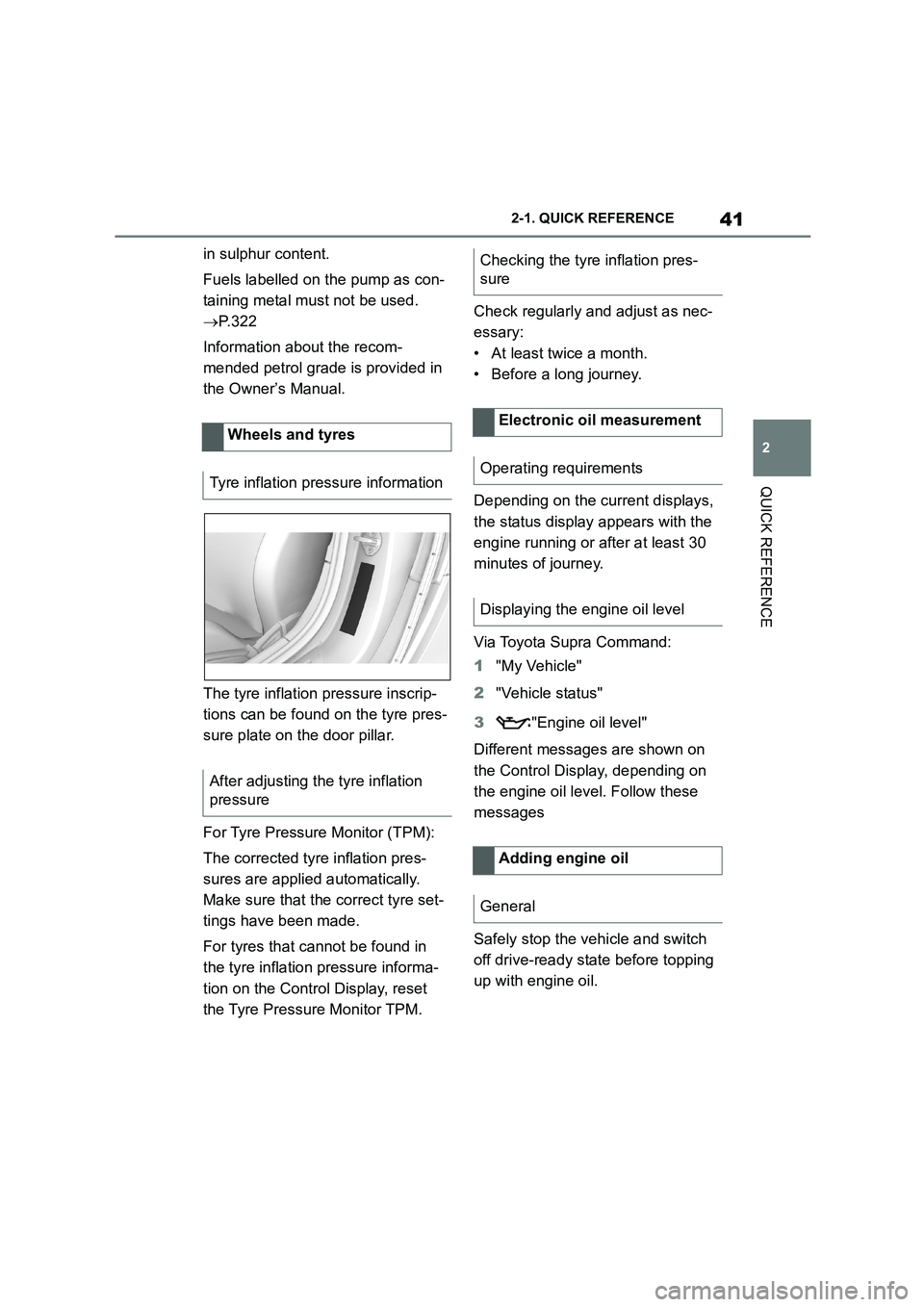
41
2
2-1. QUICK REFERENCE
QUICK REFERENCE
in sulphur content.
Fuels labelled on the pump as con-
taining metal must not be used.
P. 3 2 2
Information about the recom-
mended petrol grade is provided in
the Owner’s Manual.
The tyre inflation pressure inscrip-
tions can be found on the tyre pres-
sure plate on the door pillar.
For Tyre Pressure Monitor (TPM):
The corrected tyre inflation pres-
sures are applied automatically.
Make sure that the correct tyre set-
tings have been made.
For tyres that cannot be found in
the tyre inflation pressure informa-
tion on the Control Display, reset
the Tyre Pressure Monitor TPM.
Check regularly and adjust as nec-
essary:
• At least twice a month.
• Before a long journey.
Depending on the current displays,
the status display appears with the
engine running or after at least 30
minutes of journey.
Via Toyota Supra Command:
1 "My Vehicle"
2 "Vehicle status"
3 "Engine oil level"
Different messages are shown on
the Control Display, depending on
the engine oil le vel. Follow these
messages
Safely stop the vehicle and switch
off drive-ready state before topping
up with engine oil.
Wheels and tyres
Tyre inflation pres sure information
After adjusting the tyre inflation
pressure
Checking the tyre inflation pres-
sure
Electronic oil measurement
Operating requirements
Displaying the engine oil level
Adding engine oil
General
Page 297 of 498
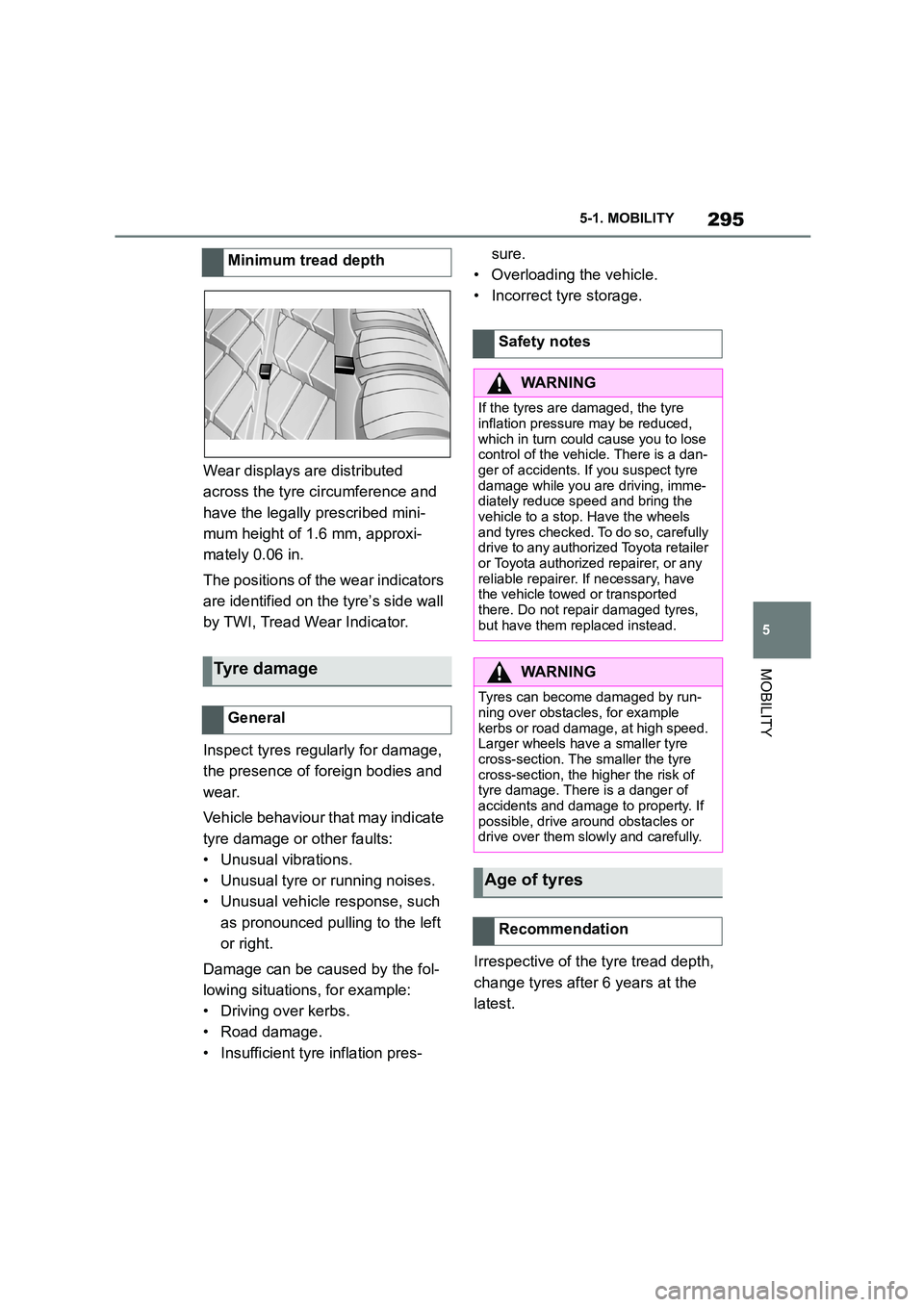
295
5
5-1. MOBILITY
MOBILITY
Wear displays are distributed
across the tyre circumference and
have the legally prescribed mini-
mum height of 1.6 mm, approxi-
mately 0.06 in.
The positions of the wear indicators
are identified on the tyre’s side wall
by TWI, Tread Wear Indicator.
Inspect tyres regularly for damage,
the presence of foreign bodies and
wear.
Vehicle behaviour that may indicate
tyre damage or other faults:
• Unusual vibrations.
• Unusual tyre or running noises.
• Unusual vehicle response, such
as pronounced pu lling to the left
or right.
Damage can be caused by the fol-
lowing situations, for example:
• Driving over kerbs.
• Road damage.
• Insufficient tyre inflation pres-
sure.
• Overloading the vehicle.
• Incorrect tyre storage.
Irrespective of the tyre tread depth,
change tyres after 6 years at the
latest.
Minimum tread depth
Tyre damage
General
Safety notes
WA R N I N G
If the tyres are damaged, the tyre
inflation pressure may be reduced,
which in turn could cause you to lose control of the vehicle. There is a dan-
ger of accidents. If you suspect tyre
damage while you are driving, imme- diately reduce speed and bring the
vehicle to a stop. Have the wheels
and tyres checked. To do so, carefully drive to any authorized Toyota retailer
or Toyota authorized repairer, or any
reliable repairer. If necessary, have the vehicle towed or transported
there. Do not repair damaged tyres,
but have them replaced instead.
WA R N I N G
Tyres can become damaged by run-
ning over obstacles, for example
kerbs or road damage, at high speed. Larger wheels have a smaller tyre
cross-section. The smaller the tyre
cross-section, the higher the risk of tyre damage. There is a danger of
accidents and damage to property. If
possible, drive around obstacles or drive over them slowly and carefully.
Age of tyres
Recommendation
Page 299 of 498
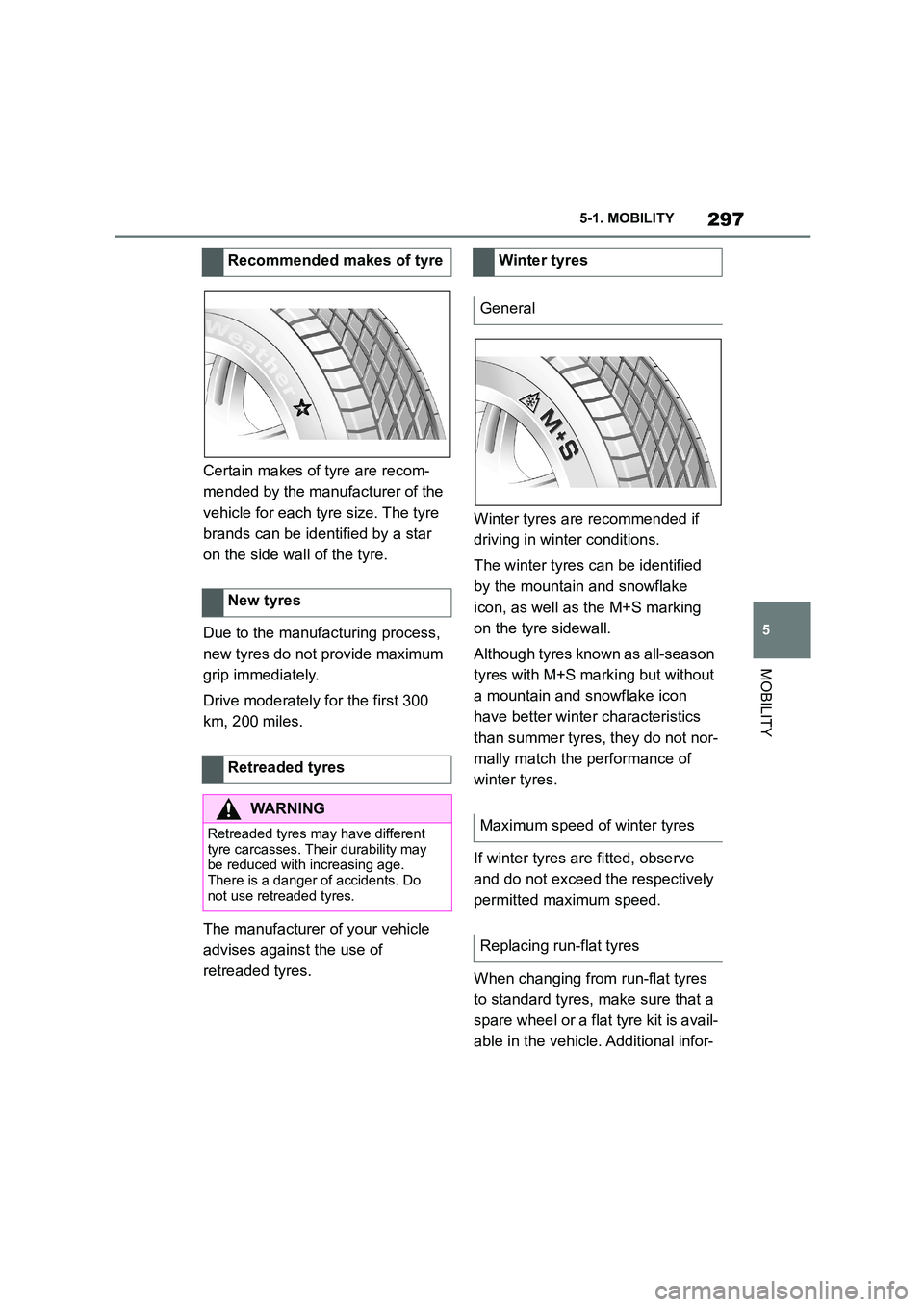
297
5
5-1. MOBILITY
MOBILITY
Certain makes of tyre are recom-
mended by the manufacturer of the
vehicle for each tyre size. The tyre
brands can be identified by a star
on the side wall of the tyre.
Due to the manufacturing process,
new tyres do not provide maximum
grip immediately.
Drive moderately for the first 300
km, 200 miles.
The manufacturer of your vehicle
advises against the use of
retreaded tyres.
Winter tyres are recommended if
driving in winter conditions.
The winter tyres can be identified
by the mountain and snowflake
icon, as well as the M+S marking
on the tyre sidewall.
Although tyres known as all-season
tyres with M+S marking but without
a mountain and snowflake icon
have better winter characteristics
than summer tyres, they do not nor-
mally match the performance of
winter tyres.
If winter tyres are fitted, observe
and do not exceed the respectively
permitted maximum speed.
When changing from run-flat tyres
to standard tyres, make sure that a
spare wheel or a flat tyre kit is avail-
able in the vehicle. Additional infor-
Recommended makes of tyre
New tyres
Retreaded tyres
WA R N I N G
Retreaded tyres may have different tyre carcasses. Their durability may
be reduced with increasing age.
There is a danger of accidents. Do not use retreaded tyres.
Winter tyres
General
Maximum speed of winter tyres
Replacing run-flat tyres
Page 300 of 498
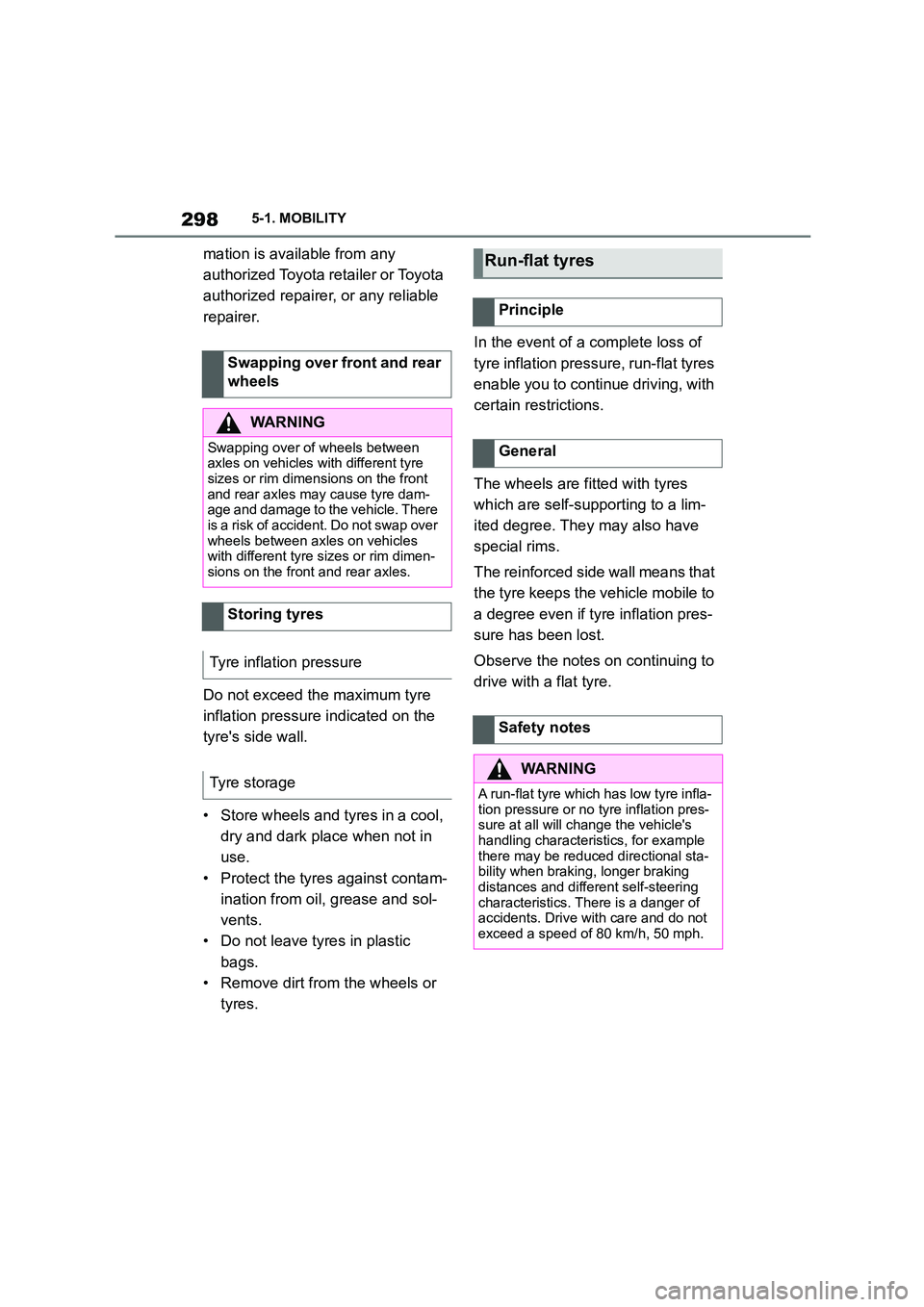
2985-1. MOBILITY
mation is available from any
authorized Toyota retailer or Toyota
authorized repairer, or any reliable
repairer.
Do not exceed the maximum tyre
inflation pressure indicated on the
tyre's side wall.
• Store wheels and tyres in a cool,
dry and dark place when not in
use.
• Protect the tyres against contam-
ination from oil, grease and sol-
vents.
• Do not leave tyres in plastic
bags.
• Remove dirt from the wheels or
tyres.
In the event of a complete loss of
tyre inflation pressure, run-flat tyres
enable you to continue driving, with
certain restrictions.
The wheels are fitted with tyres
which are self-supporting to a lim-
ited degree. They may also have
special rims.
The reinforced side wall means that
the tyre keeps the vehicle mobile to
a degree even if tyre inflation pres-
sure has been lost.
Observe the notes on continuing to
drive with a flat tyre.
Swapping over front and rear
wheels
WA R N I N G
Swapping over of wheels between
axles on vehicles with different tyre
sizes or rim dimensions on the front and rear axles may cause tyre dam-
age and damage to the vehicle. There
is a risk of accident. Do not swap over wheels between axles on vehicles
with different tyre sizes or rim dimen-
sions on the front and rear axles.
Storing tyres
Tyre inflation pressure
Tyre storage
Run-flat tyres
Principle
General
Safety notes
WA R N I N G
A run-flat tyre which has low tyre infla-
tion pressure or no tyre inflation pres- sure at all will change the vehicle's
handling characteristics, for example
there may be reduced directional sta- bility when braking, longer braking
distances and different self-steering
characteristics. There is a danger of accidents. Drive with care and do not
exceed a speed of 80 km/h, 50 mph.
Page 301 of 498

299
5
5-1. MOBILITY
MOBILITY
The tyres are identified on the tyre's
side wall by RSC Runflat System
Component.
• Park the vehicle on a firm sur-
face and as far away from mov-
ing traffic as possible.
• Switch on the hazard warning
lights.
• Apply the parking brake to pre-
vent the vehicle rolling away.
• Engage the steering wheel lock
with the wheels in the
straight-ahead position.
• Have all vehicle occupants get
out of the vehicle and guide them
out of the danger area, for exam-
ple behind the crash barrier.
• Set up the warning triangle an
appropriate distance away.
With the Mobility System, minor
tyre damage can be quickly sealed,
to allow you to drive on. For this
purpose, liquid sealant is pumped
into the tyres which encloses the
damage from the inside when it
hardens.
• Please observe the notes on the
application of the Mobility Sys-
tem which are on the compres-
sor and the sealant container.
• Applying the Mobility System can
be ineffective for tyre damage
larger than approximately 4 mm.
• Contact any authorized Toyota
retailer or Toyota authorized
repairer, or any reliable repairer if
you are unable to put the tyre
back in operation.
• Foreign bodies that have pene-
trated the tyre should remain
inside the tyre. Only remove for-
eign objects if they are visibly
protruding from the tyre.
• Remove the speed limit sticker
from the sealant container and
attach to the steering wheel.
• Using sealants can damage the
TPM wheel electronics. In this
case, have the electronics
replaced at the next opportunity.
• The compressor can be used to
Label
Remedying flat tyres
Safety measures
Mobility System
Principle
General
Page 304 of 498
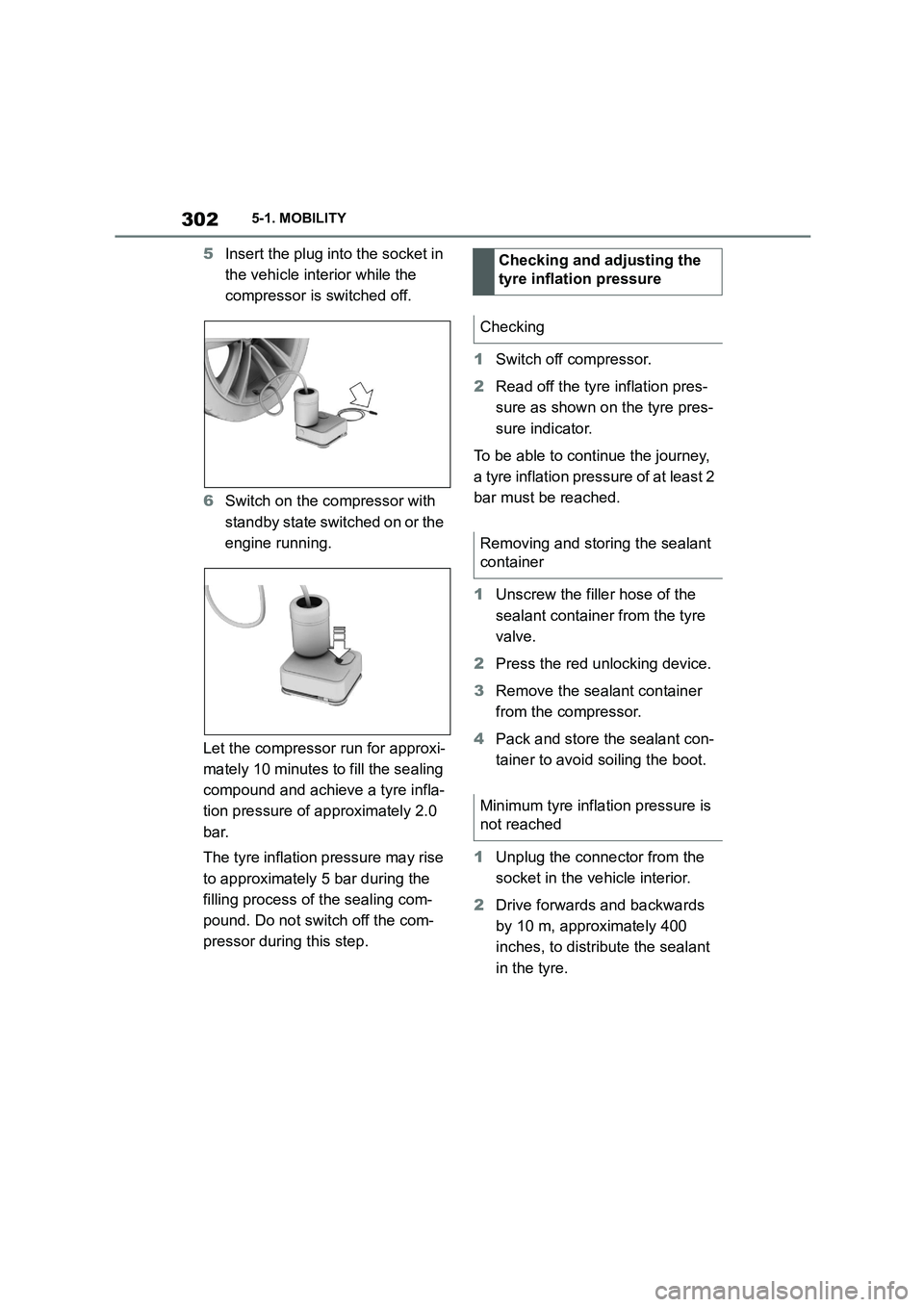
3025-1. MOBILITY
5Insert the plug into the socket in
the vehicle interior while the
compressor is switched off.
6 Switch on the compressor with
standby state switched on or the
engine running.
Let the compressor run for approxi-
mately 10 minutes to fill the sealing
compound and achieve a tyre infla-
tion pressure of approximately 2.0
bar.
The tyre inflation pressure may rise
to approximately 5 bar during the
filling process of the sealing com-
pound. Do not switch off the com-
pressor during this step.
1 Switch off compressor.
2 Read off the tyre inflation pres-
sure as shown on the tyre pres-
sure indicator.
To be able to continue the journey,
a tyre inflation pressure of at least 2
bar must be reached.
1 Unscrew the filler hose of the
sealant container from the tyre
valve.
2 Press the red unlocking device.
3 Remove the sealant container
from the compressor.
4 Pack and store the sealant con-
tainer to avoid soiling the boot.
1 Unplug the connector from the
socket in the vehicle interior.
2 Drive forwards and backwards
by 10 m, approximately 400
inches, to distribute the sealant
in the tyre.
Checking and adjusting the
tyre inflation pressure
Checking
Removing and storing the sealant
container
Minimum tyre inflation pressure is
not reached
Page 305 of 498
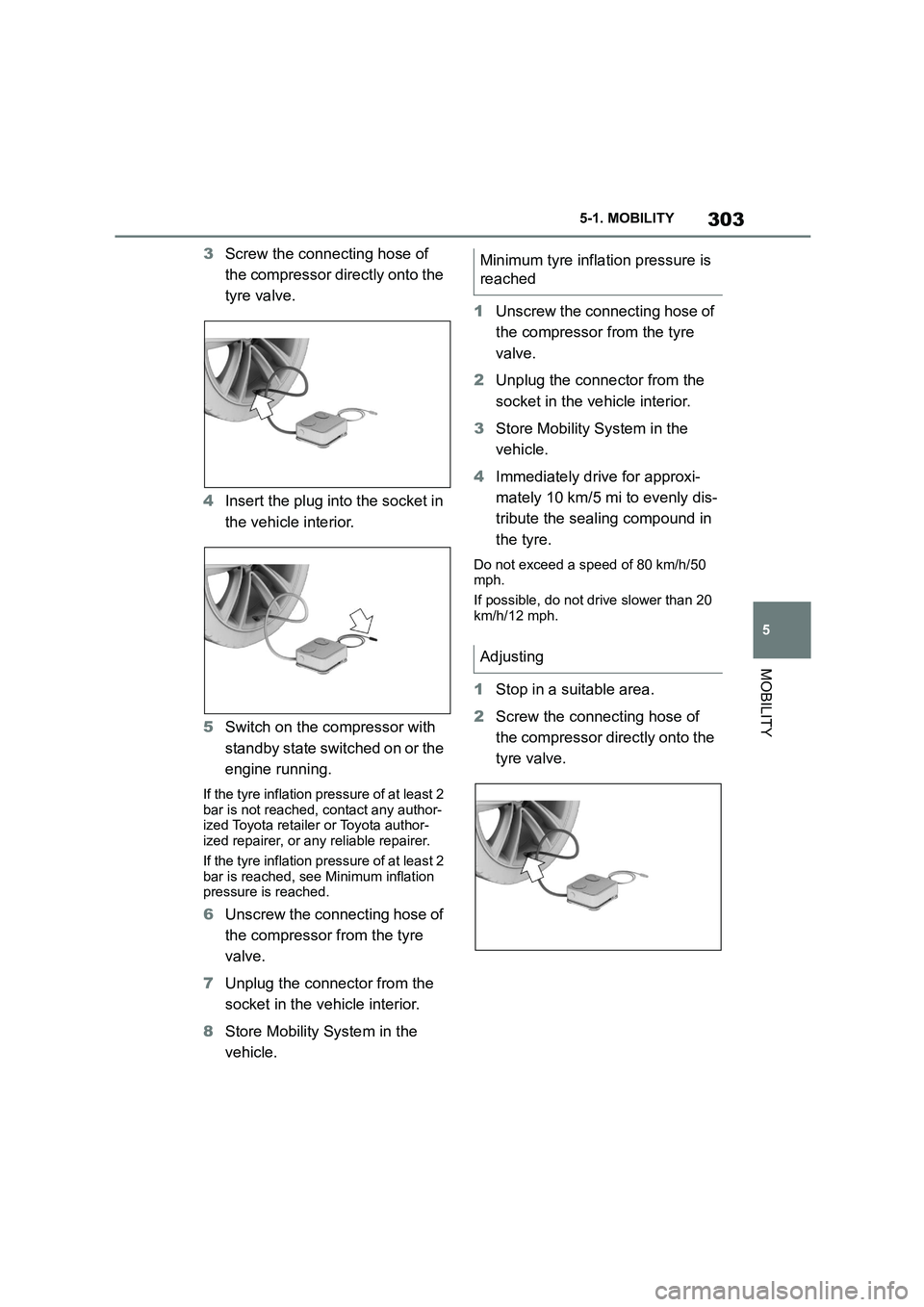
303
5
5-1. MOBILITY
MOBILITY
3 Screw the connecting hose of
the compressor directly onto the
tyre valve.
4 Insert the plug into the socket in
the vehicle interior.
5 Switch on the compressor with
standby state switched on or the
engine running.
If the tyre inflation pressure of at least 2
bar is not reached, contact any author-
ized Toyota retailer or Toyota author- ized repairer, or any reliable repairer.
If the tyre inflation pressure of at least 2
bar is reached, see Minimum inflation pressure is reached.
6 Unscrew the connecting hose of
the compressor from the tyre
valve.
7 Unplug the connector from the
socket in the vehicle interior.
8 Store Mobility System in the
vehicle.
1 Unscrew the connecting hose of
the compressor from the tyre
valve.
2 Unplug the connector from the
socket in the vehicle interior.
3 Store Mobility System in the
vehicle.
4 Immediately drive for approxi-
mately 10 km/5 mi to evenly dis-
tribute the sealing compound in
the tyre.
Do not exceed a speed of 80 km/h/50 mph.
If possible, do not drive slower than 20
km/h/12 mph.
1 Stop in a suitable area.
2 Screw the connecting hose of
the compressor directly onto the
tyre valve.
Minimum tyre inflation pressure is
reached
Adjusting
Page 306 of 498
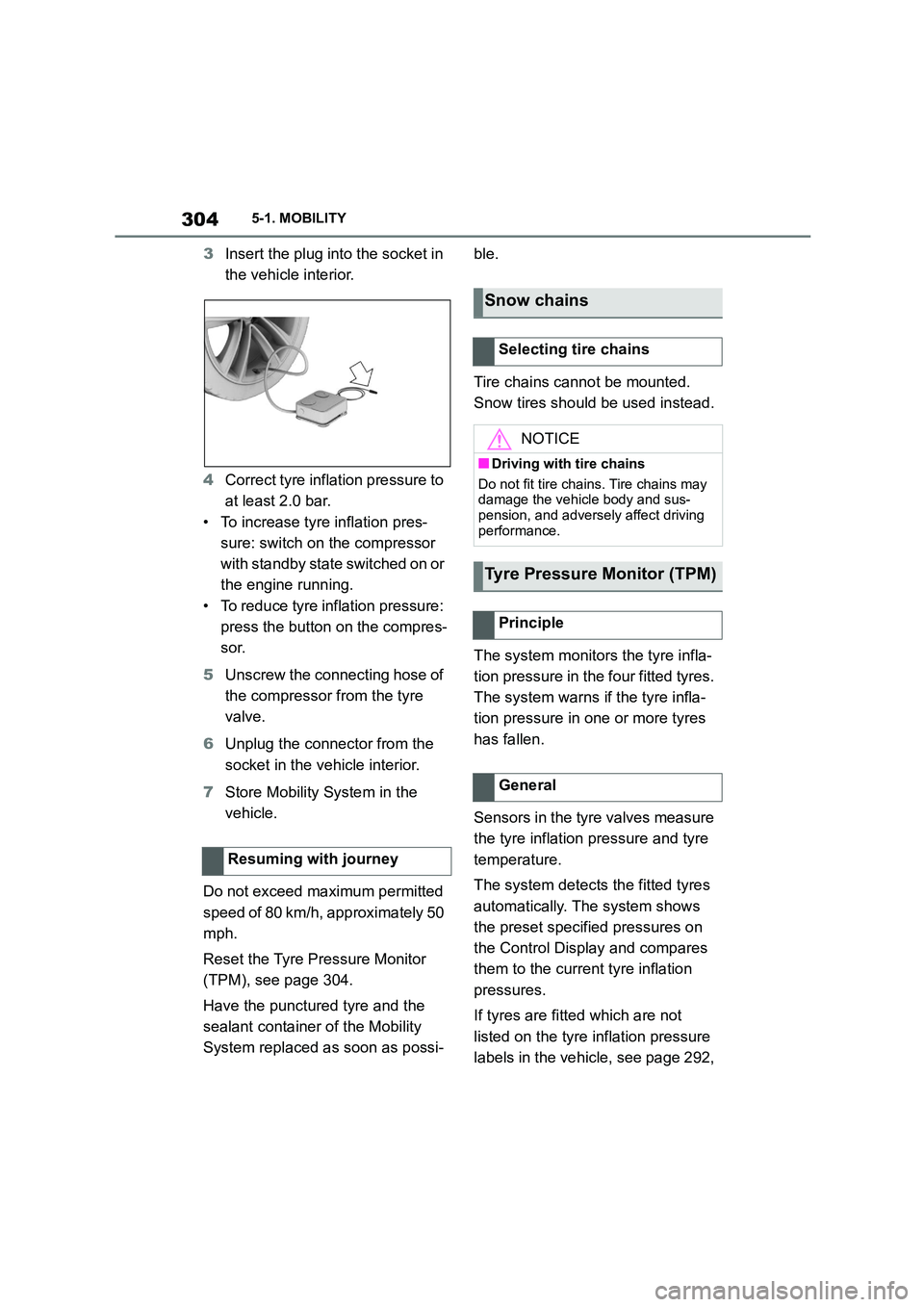
3045-1. MOBILITY
3Insert the plug into the socket in
the vehicle interior.
4 Correct tyre inflation pressure to
at least 2.0 bar.
• To increase tyre inflation pres-
sure: switch on the compressor
with standby state switched on or
the engine running.
• To reduce tyre inflation pressure:
press the button on the compres-
sor.
5 Unscrew the connecting hose of
the compressor from the tyre
valve.
6 Unplug the connector from the
socket in the vehicle interior.
7 Store Mobility System in the
vehicle.
Do not exceed maximum permitted
speed of 80 km/h, approximately 50
mph.
Reset the Tyre Pressure Monitor
(TPM), see page 304.
Have the punctured tyre and the
sealant containe r of the Mobility
System replaced as soon as possi-
ble.
Tire chains cannot be mounted.
Snow tires should be used instead.
The system monitors the tyre infla-
tion pressure in the four fitted tyres.
The system warns if the tyre infla-
tion pressure in one or more tyres
has fallen.
Sensors in the tyre valves measure
the tyre inflation pressure and tyre
temperature.
The system detects the fitted tyres
automatically. The system shows
the preset specified pressures on
the Control Display and compares
them to the current tyre inflation
pressures.
If tyres are fitted which are not
listed on the tyre inflation pressure
labels in the vehicle, see page 292,
Resuming with journey
Snow chains
Selecting tire chains
NOTICE
■Driving with tire chains
Do not fit tire chains. Tire chains may
damage the vehicle body and sus- pension, and adversely affect driving
performance.
Tyre Pressure Monitor (TPM)
Principle
General
Page 310 of 498
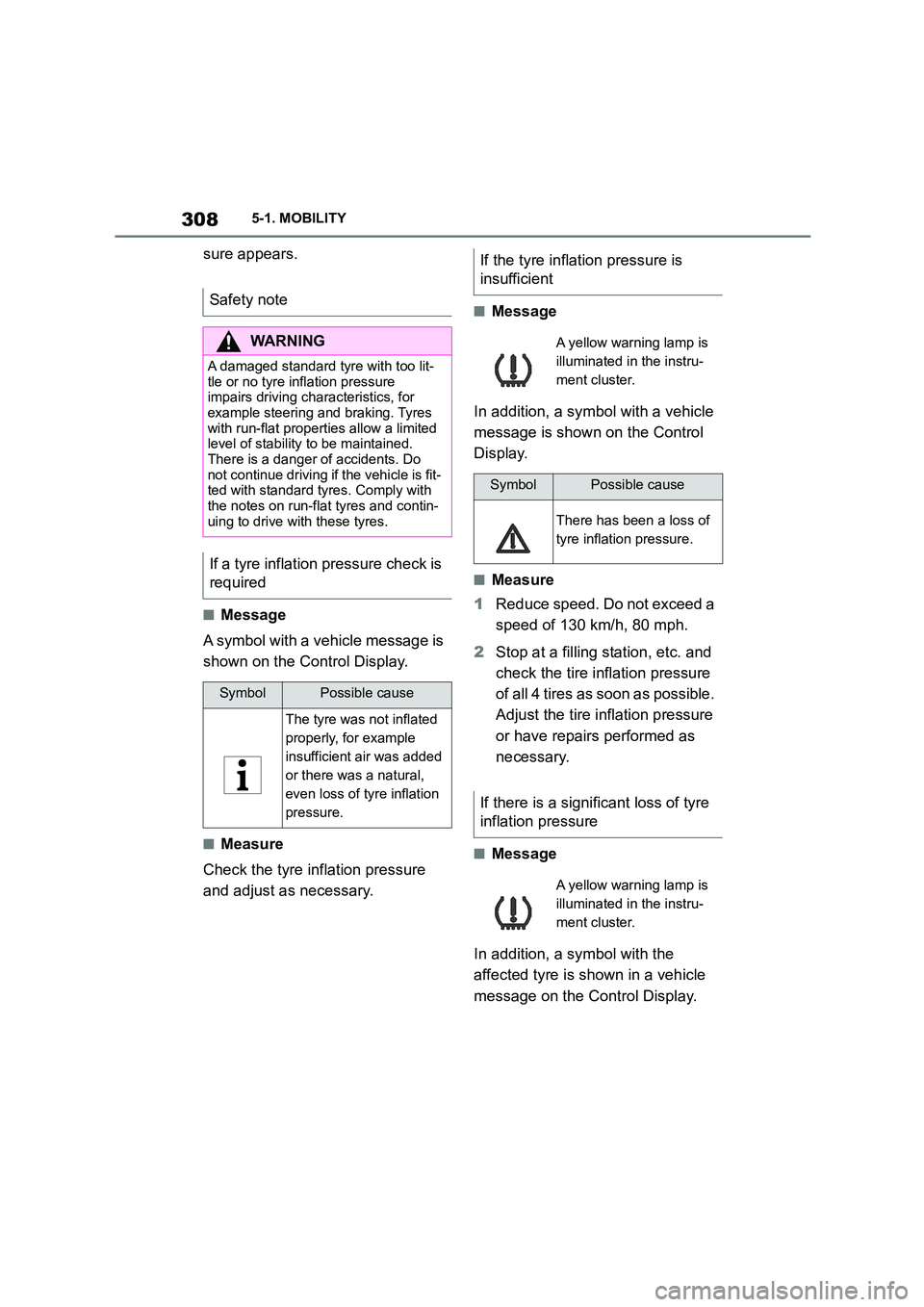
3085-1. MOBILITY
sure appears.
■Message
A symbol with a vehicle message is
shown on the Control Display.
■Measure
Check the tyre inflation pressure
and adjust as necessary.
■Message
In addition, a symbol with a vehicle
message is shown on the Control
Display.
■Measure
1 Reduce speed. Do not exceed a
speed of 130 km/h, 80 mph.
2 Stop at a filling station, etc. and
check the tire in flation pressure
of all 4 tires as soon as possible.
Adjust the tire inflation pressure
or have repairs performed as
necessary.
■Message
In addition, a symbol with the
affected tyre is shown in a vehicle
message on the Control Display.
Safety note
WA R N I N G
A damaged standard tyre with too lit-
tle or no tyre inflation pressure impairs driving characteristics, for
example steering and braking. Tyres
with run-flat properties allow a limited
level of stability to be maintained. There is a danger of accidents. Do
not continue driving if the vehicle is fit-
ted with standard tyres. Comply with the notes on run-flat tyres and contin-
uing to drive with these tyres.
If a tyre inflation pressure check is
required
SymbolPossible cause
The tyre was not inflated
properly, for example
insufficient air was added
or there was a natural,
even loss of tyre inflation
pressure.
If the tyre inflation pressure is
insufficient
A yellow warning lamp is
illuminated in the instru-
ment cluster.
SymbolPossible cause
There has been a loss of
tyre inflation pressure.
If there is a significant loss of tyre
inflation pressure
A yellow warning lamp is
illuminated in the instru-
ment cluster.
Page 311 of 498
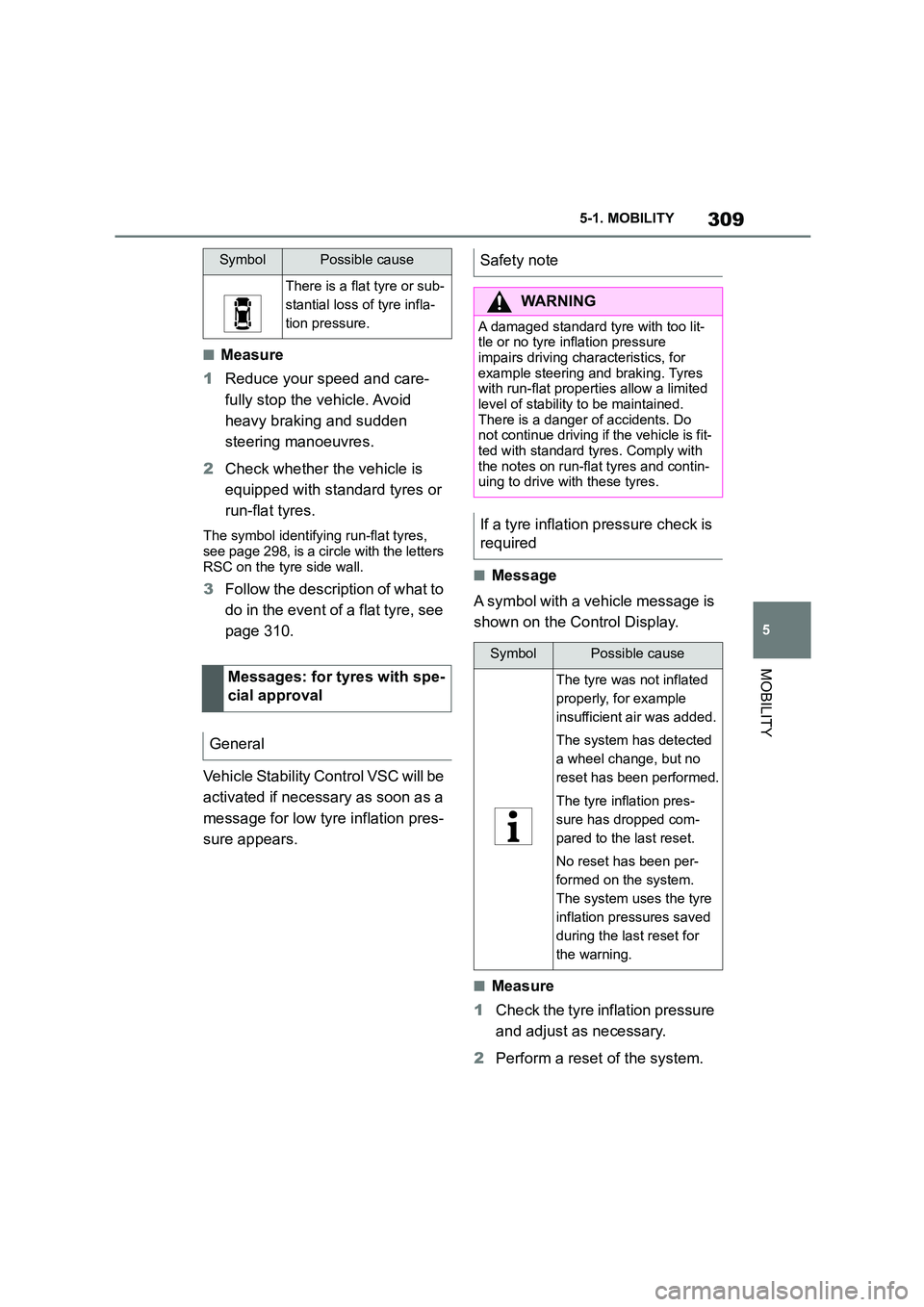
309
5
5-1. MOBILITY
MOBILITY
■Measure
1 Reduce your speed and care-
fully stop the vehicle. Avoid
heavy braking and sudden
steering manoeuvres.
2 Check whether the vehicle is
equipped with standard tyres or
run-flat tyres.
The symbol identifying run-flat tyres,
see page 298, is a circle with the letters
RSC on the tyre side wall.
3 Follow the description of what to
do in the event of a flat tyre, see
page 310.
Vehicle Stability Control VSC will be
activated if necessary as soon as a
message for low tyre inflation pres-
sure appears.
■Message
A symbol with a vehicle message is
shown on the Control Display.
■Measure
1 Check the tyre inflation pressure
and adjust as necessary.
2 Perform a reset of the system.
SymbolPossible cause
There is a flat tyre or sub-
stantial loss of tyre infla-
tion pressure.
Messages: for tyres with spe-
cial approval
General
Safety note
WA R N I N G
A damaged standard tyre with too lit-
tle or no tyre inflation pressure impairs driving char acteristics, for
example steering and braking. Tyres
with run-flat properties allow a limited level of stability to be maintained.
There is a danger of accidents. Do
not continue driving if the vehicle is fit-
ted with standard tyres. Comply with the notes on run-flat tyres and contin-
uing to drive with these tyres.
If a tyre inflation pressure check is
required
SymbolPossible cause
The tyre was not inflated
properly, for example
insufficient air was added.
The system has detected
a wheel change, but no
reset has been performed.
The tyre inflation pres-
sure has dropped com-
pared to the last reset.
No reset has been per-
formed on the system.
The system uses the tyre
inflation pressures saved
during the last reset for
the warning.